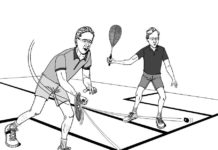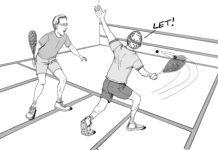by Barry Faguy
HEY REF Once in a while when it’s my turn to referee, I wind up with bad behavior from the players and I get flustered and unsure of what to do.
Poor behavior is part of many sports. Squash is no exception, particularly because the players are typically in close proximity, vying for dominant positions in the space available. Add to that the fact that many of the officiating decisions are subjective (for example: was the ball reachable, did the player make every effort, was the swing reasonable?). Odds are that your being flustered comes from having witnessed some of these unpleasant conflicts; maybe you’ve even had your own share.
SOURCES
Unpleasant conduct comes from a player upset at their own bad play; from a player upset with what they perceive as their opponent’s unfair or aggressive play; and lastly, and most commonly, from a player upset with what they perceive as the ref’s bad decision. The resulting behaviors can run a broad gamut from simple skewed looks, to snarky remarks, to loud protests, to audible and visible obscenities (blasphemy, profanity), to equipment abuse (smashed racquets), to court abuse (slammed door), to opponent abuse (aggressive shoving) and yes, to referee abuse.
APPROACHES
No matter the source of the behavior, we often see such incidents go ignored by the referee. Not surprisingly, some players and spectators view that as condoning the behavior. Doing nothing is rarely an option if you want to encourage appropriate sportsmanship and fair play for the rest of the match. Here’s a reasonable approach:
- Prevention
Start here. Although not a guarantee, rendering fair decisions is a first step. Practice your refereeing, complete referee training and testing, and make sure you are comfortable with the rules. Doing so will allow you to project confidence in your decisions and set the players on a course to focus on the match, not on the referee.
- Warnings
Once any unwanted behavior has occurred, you need to take action. If the behavior isn’t too egregious, then it’s entirely reasonable (and often wiser) to start with an informal warning. It can be quite effective in preventing escalation because it alerts both players to your expected standards of conduct. An example would be: “Mr. Smith, please refrain from hitting your racket against the wall.” Then, if this fails to produce the desired change, you can go formal with: “conduct warning Smith for racket abuse”.
- Penalties
Worsening behavior leaves you with little choice but to tighten the screws, using either a conduct stroke, conduct game or conduct match. Contrary to popular belief, you can issue any of these right off the bat; you don’t need to start with the lowest penalty. As well, any subsequent penalty need not be more severe than the previous; if you assessed a conduct stroke for racquet abuse, you can do the exact same thing the next time it happens. However, you can’t go backwards; you may not give a lesser penalty for a repeat offense.
- Final Advice
- When faced with a criticism, be sure to distinguish if it’s a criticism of themselves, a criticism of the decision or a criticism of you. You should deal with these in a decreasing order of tolerance.
- Show respect by answering a reasonable question rather than imperiously dismissing it. Mutual civility should be a hallmark of any player-referee interaction.
- Imposing yourself too easily or too aggressively can create a toxic environment.
- When the time has come to invoke the conduct rule, do it with authority. Make your statement clearly, even first using “Stop” if necessary to get everyone’s attention—simply because it’s not unusual to see conduct decisions get lost in the clamor that often accompanies these situations.





